Effects of Canopy and Multi-Epoch Observations on Single-Point Positioning Errors of a GNSS in Coniferous and Broadleaved Forests
Abstract
1. Introduction
2. Materials and Methods
2.1. Study Area
2.2. Data Acquisition
2.3. Data Processing
2.4. Statistical Analysis
2.5. Construction of the Positioning Error Model
3. Results
3.1. Positioning Accuracy of Different Multi-Epoch Data
3.2. Comparison of Single-Point Positioning Errors between Coniferous and Broadleaved Forest Species
3.3. Verification and Analysis of the Positioning Error Model
4. Discussion
5. Conclusions
Author Contributions
Funding
Acknowledgments
Conflicts of Interest
References
- Næsset, E.; Gjevestad, J.G. Performance of gps precise point positioning under conifer forest canopies. Photogramm. Eng. Remote Sens. 2008, 74, 661–668. [Google Scholar] [CrossRef]
- Chen, Q. Effects of forest canopy, landform and distance on GPS positioning accuracy. Technol. Soil Water Conserv. 1999, 58–61. (In Chinese) [Google Scholar]
- Muscarella, R.; Kolyaie, S.; Morton, D.C.; Zimmerman, J.K.; Uriarte, M. Effects of topography on tropical forest structure depend on climate context. J. Ecol. 2020, 108, 145–159. [Google Scholar] [CrossRef]
- Deckert, C.; Bolstad, P.V. Forest canopy, terrain, and distance effects on global positioning system point accuracy. Photogramm. Eng. Remote Sens. 1996, 62, 317–321. [Google Scholar]
- Chen, S.; Liu, H.; Feng, Z.; Shen, C.; Chen, P. Applicability of personal laser scanning in forestry inventory. PLoS ONE 2019, 14, e0211392. [Google Scholar] [CrossRef]
- Fan, Y.; Feng, Z.; Mannan, A.; Khan, T.U.; Shen, C.; Saeed, S. Estimating tree position, diameter at breast height, and tree height in real-time using a mobile phone with rgb-d slam. Remote Sens. 2018, 10, 1845. [Google Scholar] [CrossRef]
- Kaartinen, H.; Hyyppä, J.; Vastaranta, M.; Kukko, A.; Jaakkola, A.; Yu, X.; Pyörälä, J.; Liang, X.; Liu, J.; Wang, Y. Accuracy of kinematic positioning using global satellite navigation systems under forest canopies. Forests 2015, 6, 3218–3236. [Google Scholar] [CrossRef]
- Prusty, S.; Sahoo, S. Detection of forest fire by using gsm & gps technology. Int. J. Intell. Comput. Appl. Sci. 2017, 5, 2322–2353. [Google Scholar]
- Shrestha, H.L. Using global positioning systems (gps) and geographic information systems (gis) in participatory mapping of community forest in nepal. Electron. J. Inf. Syst. Dev. Ctries. 2006, 25, 1–11. [Google Scholar] [CrossRef]
- Ying, L.; Zhu, Y.; Li, Y.; Chao, N. The embedded information acquisition system of forest resource. Telkomnika Indones. J. Electr. Eng. 2012, 10, 1843–1848. [Google Scholar]
- Keefe, F.R.; Wempe, M.A.; Becker, M.R.; Zimbelman, G.E.; Nagler, S.E.; Gilbert, L.S.; Caudill, C.C. Positioning methods and the use of location and activity data in forests. Forests 2019, 10, 458. [Google Scholar] [CrossRef]
- Toledo-Moreo, R.; Betaille, D.; Peyret, F.; Laneurit, J. Fusing gnss, dead-reckoning, and enhanced maps for road vehicle lane-level navigation. IEEE J. Sel. Top. Signal Process. 2009, 3, 798–809. [Google Scholar] [CrossRef]
- Weaver, S.A.; Ucar, Z.; Bettinger, P.; Merry, K. How a gnss receiver is held may affect static horizontal position accracy. PLoS ONE 2015, 10, e0124696. [Google Scholar]
- Pau, L.-F.; Klamerus-Iwan, A.; Kormanek, M.; Gołąb, J.; Owsiak, K. Robotic forest harvesting process using gnss satellite positioning data: Effects of gnss inaccuracies in forest environments. In Electronic Journal of Polish Agricultural Universities; Electronic Journal of Polish Agricultural Universities: Krakow, Poland, 2016. [Google Scholar]
- Schubert, F.; Fleury, B.; Robertson, P.; Prieto-Cerdeira, R.; Steingass, A.; Lehner, A. Modeling of multipath propagation components caused by trees and forests. In Proceedings of the Fourth European Conference on Antennas and Propagation, Barcelona, Spain, 12–16 April 2010; pp. 1–5. [Google Scholar]
- Koh, I.; Sarabandi, K. Performance characterization of gps receivers under tree canopies. In Proceedings of the IEEE Antennas and Propagation Society International Symposium. Transmitting Waves of Progress to the Next Millennium. 2000 Digest. Held in conjunction with: USNC/URSI National Radio Science Meeting, Salt Lake City, UT, USA, 16–21 July 2000; Volume 431, pp. 438–441. [Google Scholar]
- Li, C. Study on the Stability of Handheld GPS Receiver in Forest Region. J. Shenzhen Polytech. 2003, 2, 6–10. (In Chinese) [Google Scholar]
- Rodríguez-Pérez, J.; Alvarez-Taboada, F.; Sanz-Ablanedo, E. Assessment of low-cost gps receiver accuracy and precision in forest environments. J. Surv. Eng. 2007, 133, 159–167. [Google Scholar] [CrossRef]
- Hasegawa, H.; Yoshimura, T. Application of dual-frequency gps receivers for static surveying under tree canopies. J. For. Res. 2003, 8, 103–110. [Google Scholar] [CrossRef]
- Brach, M.; Zasada, M. The effect of mounting height on gnss receiver positioning accuracy in forest conditions. Croat. J. For. Eng. 2014, 35, 245. [Google Scholar]
- Hoppus, M.; Lister, A. The status of accurately locating forest inventory and analysis plots using the global positioning system. In Proceedings of the Seventh Annual Forest Inventory and Analysis Symposium, Washington, DC, USA, 3–6 October 2005. [Google Scholar]
- Sigrist, P.; Coppin, P.; Hermy, M. Impact of forest canopy on quality and accuracy of gps measurements. Int. J. Remote Sens. 1999, 20, 3595–3610. [Google Scholar] [CrossRef]
- Abdi, E.; Mariv, H.S.; Deljouei, A.; Sohrabi, H. Accuracy and precision of consumer-grade gps positioning in an urban green space environment. For. Sci. Technol. 2014, 10, 141–147. [Google Scholar] [CrossRef]
- Tomaštík, J.; Saloň, Š.; Piroh, R. Horizontal accuracy and applicability of smartphone gnss positioning in forests. Forestry 2017, 92, 187–198. [Google Scholar] [CrossRef]
- Feng, Z.K.; You, X.X. Study on the Influence of Forest Crown Mountain on GPS Measurement Accuracy. In New Century New Opportunities New Challenges-Knowledge Innovation and High-Tech Industry Development; Academic department of Chinese Association of Science and Technology: Changchun, Jilin, China, 2001; Volume 2. (In Chinese) [Google Scholar]
- Sawaguchi, I.; Saitoh, Y.; Tatsukawa, S. A study of the effects of stems and canopies on the signal to noise ratio of gps signals. J. For. Res. 2005, 10, 395–401. [Google Scholar] [CrossRef]
- Yin, X.; Bao, Q.; Wang, H.; Meng, Y.; Wang, Y. Spatial Continuity Test Method and Device of Remote Sensing Satellite Data; Intellectual Property Press: Beijing, China, 2020. (In Chinese) [Google Scholar]
- Hasegawa, H.; Yoshimura, T. Estimation of gps positional accuracy under different forest conditions using signal interruption probability. J. For. Res. 2007, 12, 1–7. [Google Scholar] [CrossRef]
- Yoshimura, T.; Hasegawa, H. Comparing the precision and accuracy of gps positioning in forested areas. J. For. Res. 2003, 8, 147–152. [Google Scholar] [CrossRef]
- Wing, M.G. Consumer-grade gps receiver measurement accuracy in varying forest conditions. Res. J. For. 2011, 5, 78–88. [Google Scholar] [CrossRef]
- Holden, N.M.; Martin, A.A.; Owende, P.M.O.; Ward, S.M. A method for relating gps performance to forest canopy. Int. J. For. Eng. 2001, 12, 51–56. [Google Scholar] [CrossRef]
- Morales, Y.; Tsubouchi, T. In Dgps, rtk-gps and starfire dgps performance under tree shading environments. In Proceedings of the 2007 IEEE International Conference on Integration Technology, Shenzhen, China, 20–24 March 2007. [Google Scholar]
- Lee, I.-S.; Ge, L. The performance of rtk-gps for surveying under challenging environmental conditions. Earth Planets Space 2006, 58, 515–522. [Google Scholar] [CrossRef]
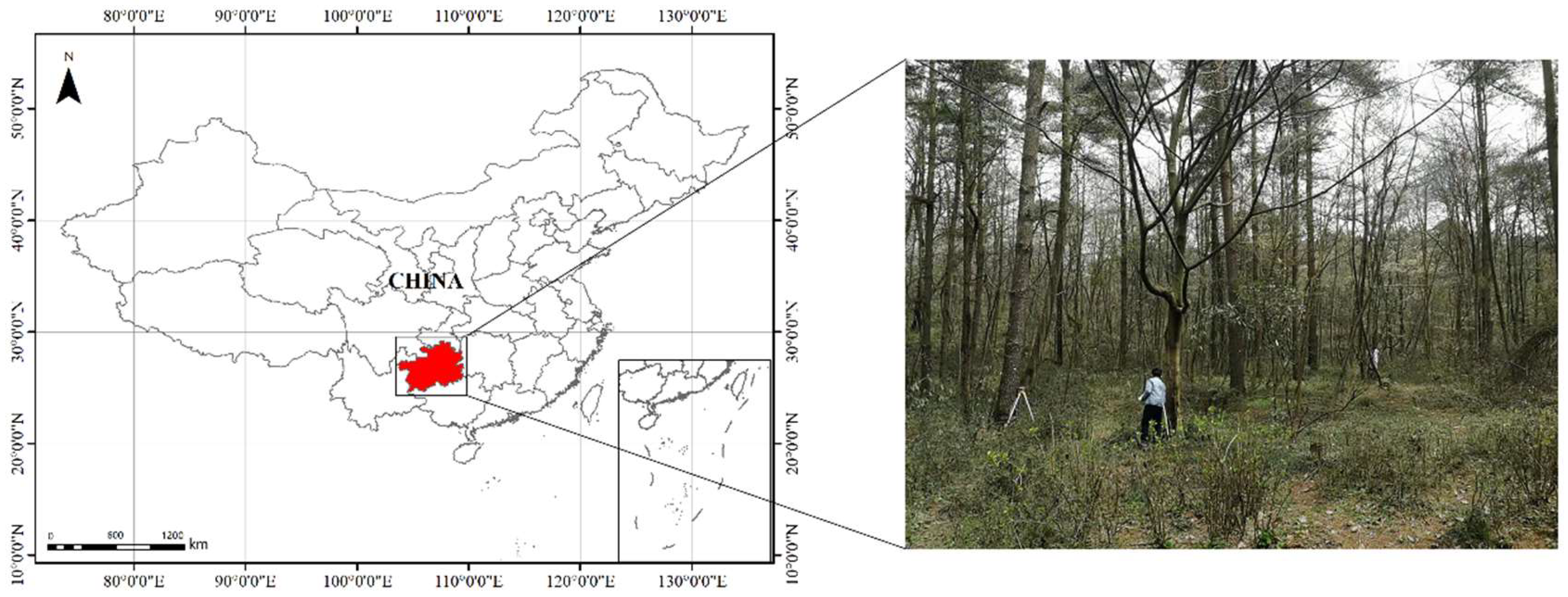
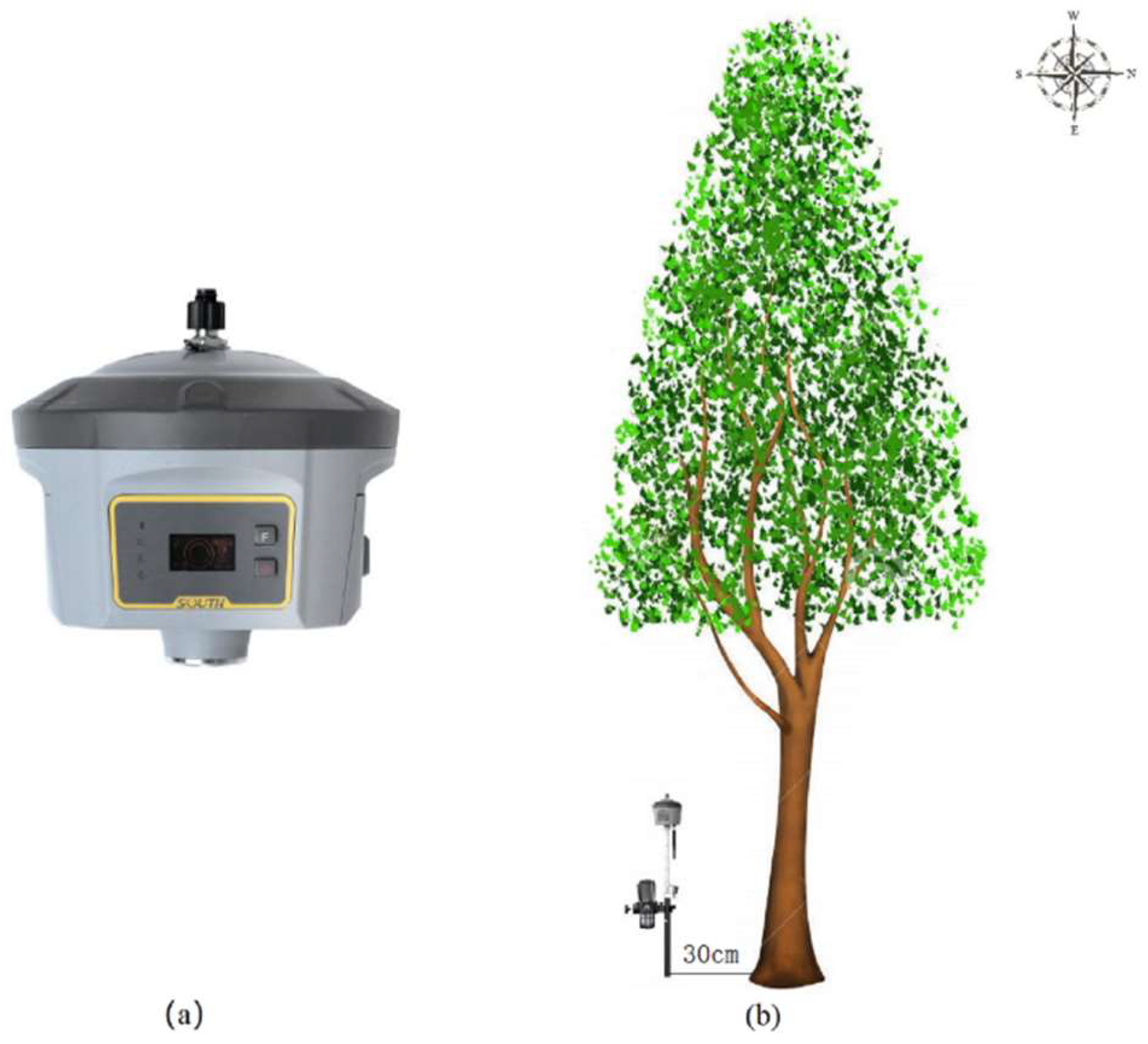
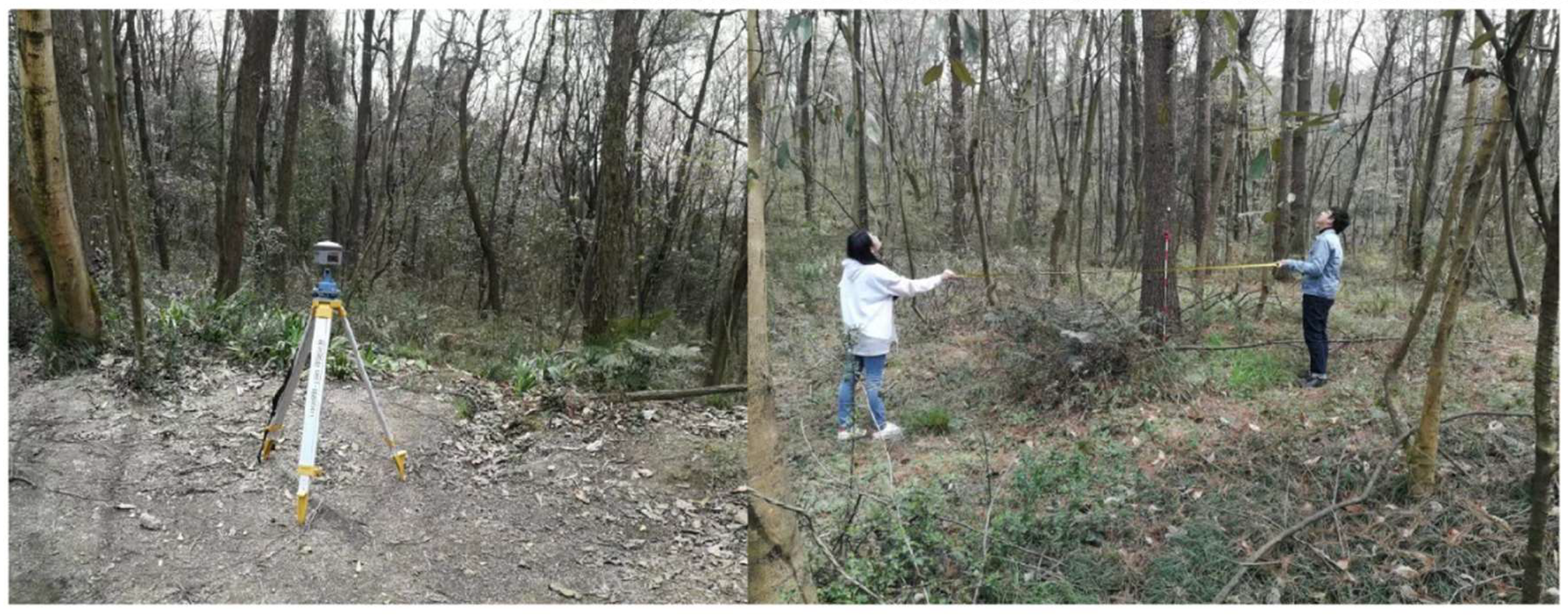
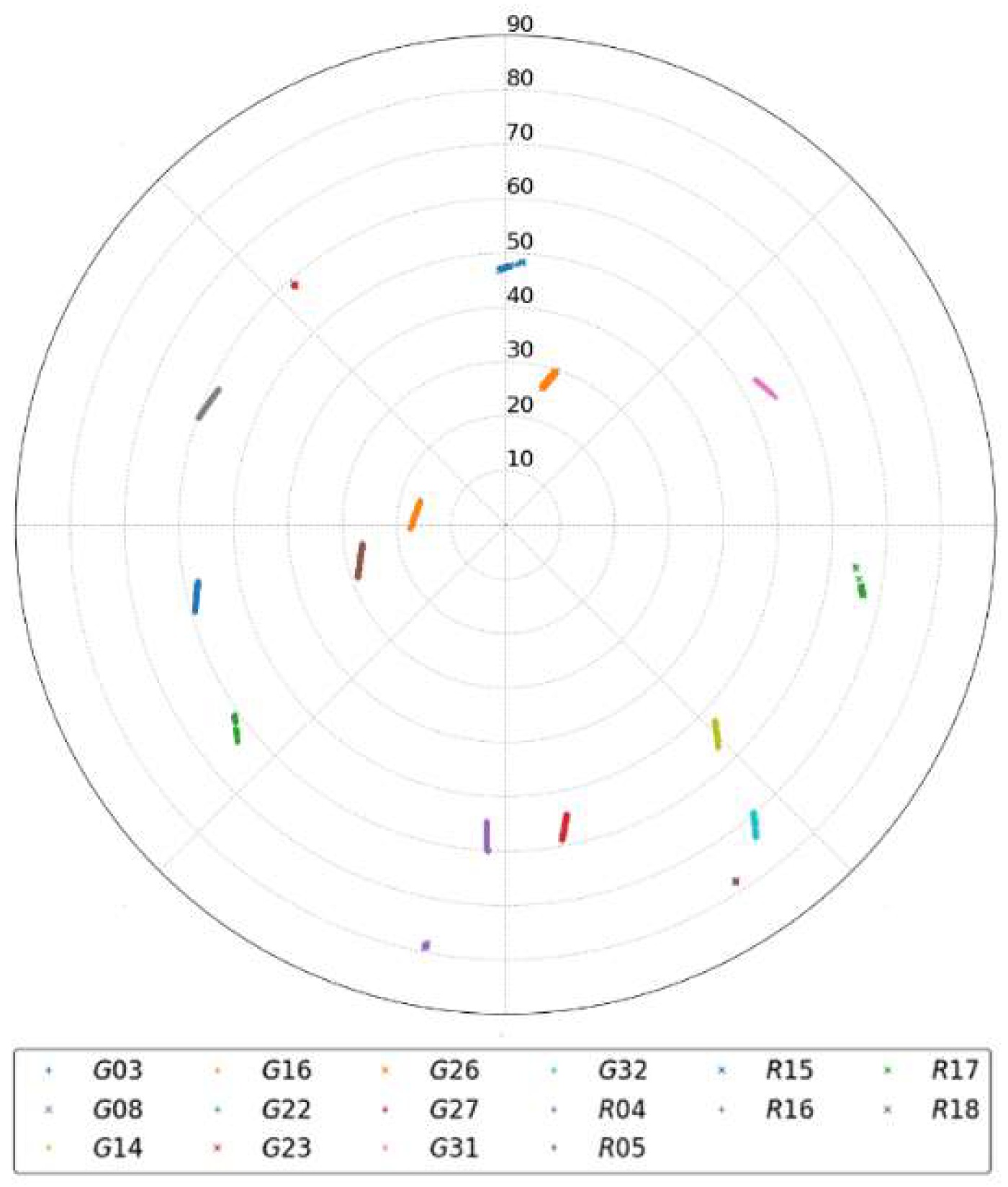
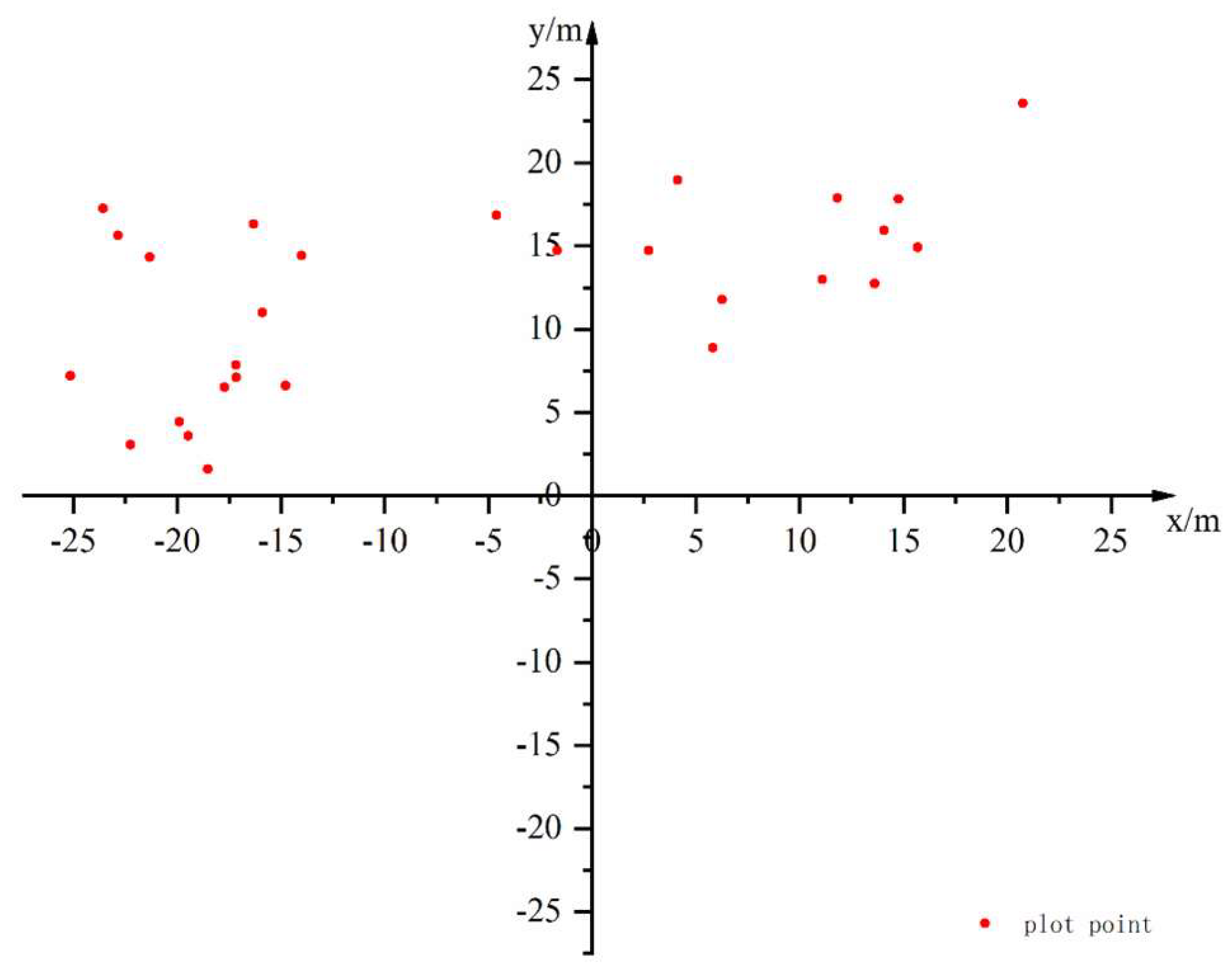
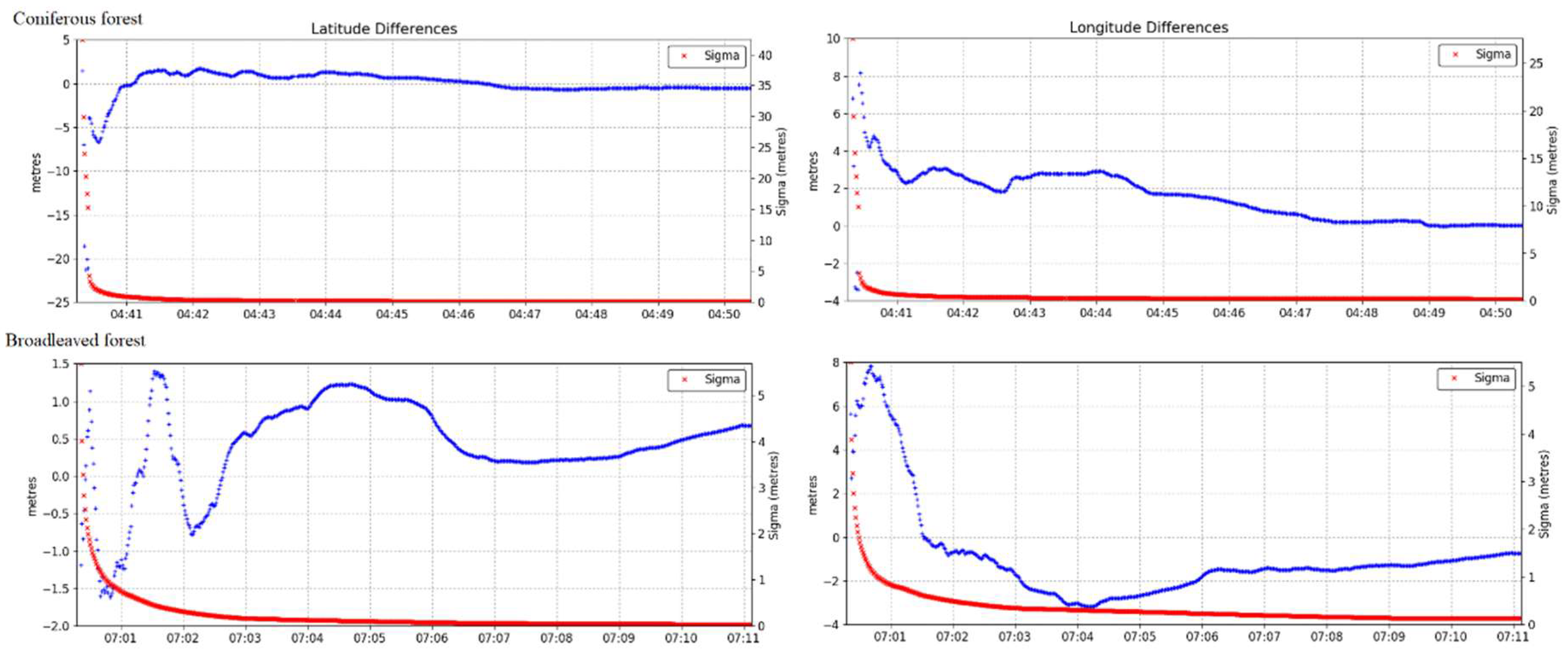
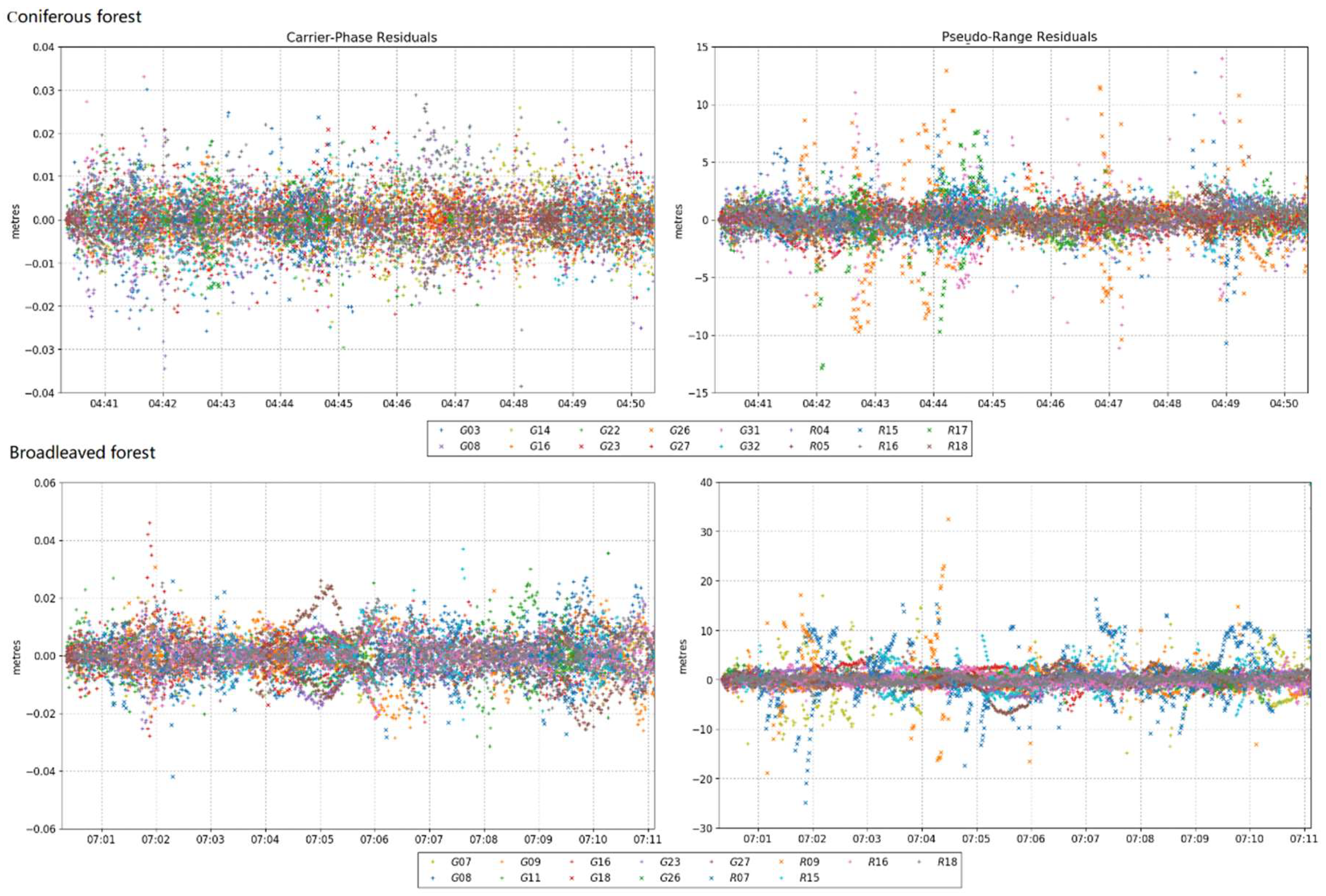
| SPECIFICATIONS | ||
|---|---|---|
| Surveying performance | Signal Tracking | BDS B1, B2, |
| GPS L1C/A, L1C, L2C, L2E, L5 | ||
| GLONASS L1C/A, L1P, L2C/A, L2P, L3 | ||
| Galileo GIOVE-A, GIOVE-B, E1, E5A, E5B | ||
| QZSS, WAAS, MSAS, EGNOS, GAGAN, SBAS | ||
| GNSS Feature | Positioning output rate: 1 HZ–50 HZ | |
| Initialization reliability: >99.99% | ||
| Positioning precision | Code Differential GNSS Positioning | Horizontal: 0.25 m + 1 ppm RMS |
| Vertical: 0.50 m + 1 ppm RMS | ||
| SBAS positioning accuracy: typically < 5 m 3DRMS | ||
| Static GNSS Surveying | Horizontal: 2.5 mm + 0.5 ppm RMS | |
| Vertical: 5 mm + 0.5 ppm RMS | ||
| Real-Time Kinematic Surveying (Baseline < 30 km) | Horizontal: 8 mm + 1 ppm RMS | |
| Vertical: 15 mm + 1 ppm RMS | ||
| Network RTK | Vertical: 15 mm + 0.5 ppm RMS | |
| Hardware performance | Dimension | 155 mm(diameter)*137 mm (height) |
| Weight | 1.44 kg (including battery) | |
| Battery life | More than 30 h (static mode), more than 15 h (RTK mode), (providing the 7*24 h battery solution) | |
| Wireless Modem | External radio transmitter 5 W/25 W | |
| Working frequency 410–470 MHz | ||
| Data transmission/format | Data Transmission | USB data transmission, FTP download, HTTP download |
| Data Format | Static data format: STH Rinex2.x and Rinex3.x etc. | |
| Differential data format: CMR+, CMR×, RTCM 2.1, RTCM 2.3, RTCM 3.0, RTCM3.1, RTCM3.2 | ||
| GPS output data format: NMEA0183, PJK plane coordinates, binary code, Trimble GSOF | ||
| Forest Type | Number | Tree Crown (m) | DBH (cm) | Tree Height (m) | ||||||
|---|---|---|---|---|---|---|---|---|---|---|
| Mean | Min | Max | Mean | Min | Max | Mean | Min | Max | ||
| Coniferous forest | 12 | 4.9 | 3.0 | 8.0 | 32.2 | 21.0 | 43.6 | 23.8 | 13.0 | 34.0 |
| Broadleaved forest | 17 | 6.4 | 3.0 | 10.0 | 23.7 | 12.4 | 38.2 | 18.9 | 10.0 | 34.0 |
| Number of Epochs | BIASx (m) | BIASy (m) | RMSEx (m) | RMSEy (m) | RMSExy (m) |
|---|---|---|---|---|---|
| 1 | −11.80 | 19.75 | 25.34 | 21.98 | 23.72 |
| 2 | −12.80 | 19.48 | 26.28 | 21.72 | 24.11 |
| 5 | −9.25 | 19.88 | 23.91 | 22.42 | 23.18 |
| 10 | −9.60 | 17.80 | 21.44 | 19.11 | 20.31 |
| 30 | −8.52 | 17.12 | 20.37 | 18.87 | 19.63 |
| 60 | −8.03 | 15.31 | 19.69 | 16.63 | 18.22 |
| 90 | −7.76 | 14.74 | 19.29 | 16.04 | 17.74 |
| 120 | −7.61 | 14.33 | 19.01 | 15.64 | 17.41 |
| 240 | −7.24 | 13.34 | 18.27 | 14.68 | 16.57 |
| 300 | −7.11 | 13.00 | 17.99 | 14.35 | 16.27 |
| 400 | −6.93 | 12.49 | 17.58 | 13.88 | 15.84 |
| 500 | −6.72 | 12.01 | 17.13 | 13.43 | 15.39 |
| total | −7.65 | 11.61 | 17.01 | 13.13 | 15.19 |
| Tree ID | Tree Species | Tree Crown/m | ∆x (m) | ∆y (m) | ∆p (m) |
|---|---|---|---|---|---|
| 1 | Broadleaved forest | 6 | 5.81 | 8.88 | 10.61 |
| 2 | Broadleaved forest | 10 | 6.28 | 11.79 | 13.35 |
| 3 | Coniferous forest | 7 | 11.10 | 13.00 | 17.09 |
| 4 | Coniferous forest | 4 | 15.69 | 14.91 | 21.64 |
| 5 | Broadleaved forest | 8 | 14.07 | 15.94 | 21.26 |
| 6 | Broadleaved forest | 4 | 13.61 | 12.75 | 18.65 |
| 7 | Coniferous forest | 5 | 11.81 | 17.88 | 21.43 |
| 8 | Broadleaved forest | 3 | 20.76 | 23.57 | 31.41 |
| 9 | Coniferous forest | 4 | 14.76 | 17.81 | 23.13 |
| 10 | Broadleaved forest | 3 | −1.67 | 14.72 | 14.82 |
| 11 | Coniferous forest | 7 | 2.71 | 14.72 | 14.97 |
| 12 | Broadleaved forest | 4 | 4.11 | 18.96 | 19.40 |
| 13 | Coniferous forest | 4 | −4.61 | 16.84 | 17.46 |
| 14 | Coniferous forest | 5 | −19.89 | 4.44 | 20.37 |
| 15 | Coniferous forest | 4 | −16.31 | 16.33 | 23.08 |
| 16 | Coniferous forest | 4 | −14.76 | 6.61 | 16.18 |
| 17 | Broadleaved forest | 9 | −15.91 | 11.00 | 19.34 |
| 18 | Broadleaved forest | 8 | −21.33 | 14.34 | 25.70 |
| 19 | Broadleaved forest | 8 | −17.73 | 6.53 | 18.89 |
| 20 | Coniferous forest | 3 | −19.48 | 3.59 | 19.81 |
| 21 | Broadleaved forest | 6 | −25.14 | 7.19 | 26.15 |
| 22 | Broadleaved forest | 3 | −17.16 | 7.86 | 18.88 |
| 23 | Coniferous forest | 4 | −18.51 | 1.59 | 18.58 |
| 24 | Coniferous forest | 8 | −17.14 | 7.10 | 18.55 |
| 25 | Broadleaved forest | 9 | −28.54 | −2.28 | 28.63 |
| 26 | Broadleaved forest | 9 | −22.24 | 3.05 | 22.44 |
| 27 | Broadleaved forest | 8 | −23.58 | 17.26 | 29.22 |
| 28 | Broadleaved forest | 6 | −-22.85 | 15.62 | 27.68 |
| 29 | Broadleaved forest | 5 | −14.01 | 14.43 | 20.12 |
| Number of Epochs | Broadleaved Forest/m | Coniferous Forest/m | ||||||||
|---|---|---|---|---|---|---|---|---|---|---|
| BIAS x | BIAS y | RMSE x | RMSE y | RMSE xy | BIAS x | BIAS y | RMSE x | RMSE y | RMSE xy | |
| 1 | −12.54 | 21.06 | 26.17 | 22.89 | 24.58 | −10.75 | 17.90 | 24.12 | 20.63 | 22.44 |
| 2 | −13.93 | 21.62 | 28.05 | 23.33 | 25.80 | −11.20 | 16.45 | 23.56 | 19.22 | 21.50 |
| 5 | −10.11 | 22.12 | 26.13 | 24.99 | 25.57 | −8.02 | 16.70 | 20.34 | 18.17 | 19.29 |
| 10 | −11.39 | 19.01 | 22.68 | 20.33 | 21.53 | −7.08 | 16.10 | 19.56 | 17.24 | 18.44 |
| 30 | −10.81 | 18.89 | 21.65 | 20.83 | 21.24 | −5.27 | 14.61 | 18.40 | 15.68 | 17.10 |
| 60 | −10.25 | 16.31 | 20.89 | 17.65 | 19.34 | −4.87 | 13.90 | 17.84 | 15.06 | 16.51 |
| 90 | −9.91 | 15.57 | 20.48 | 16.89 | 18.77 | −4.72 | 13.56 | 17.48 | 14.75 | 16.17 |
| 120 | −9.73 | 15.08 | 20.18 | 16.40 | 18.39 | −4.60 | 13.28 | 17.22 | 14.50 | 15.92 |
| 240 | −9.27 | 13.87 | 19.41 | 15.22 | 17.44 | −4.37 | 12.59 | 16.52 | 13.88 | 15.26 |
| 300 | −9.11 | 13.47 | 19.13 | 14.83 | 17.12 | −4.28 | 12.33 | 16.24 | 13.64 | 15.00 |
| 400 | −8.90 | 12.89 | 18.72 | 14.29 | 16.65 | −4.12 | 11.94 | 15.83 | 13.29 | 14.62 |
| 500 | −8.71 | 12.32 | 18.31 | 13.76 | 16.20 | −3.90 | 11.56 | 15.30 | 12.95 | 14.18 |
| total | −9.26 | 11.94 | 17.95 | 13.44 | 15.85 | −4.95 | 11.07 | 15.32 | 12.59 | 14.02 |
| Model | m | a | b | b1 | b2 | R2adj | Significance |
|---|---|---|---|---|---|---|---|
| General | 29 | 31.47 | 3.25 | 0 | 0 | 0.579 | 0.000 |
| Coniferous | 12 | 28.99 | 0 | 3.54 | 0 | 0.701 | 0.000 |
| Broadleaved | 17 | 32.81 | 0 | 0 | 3.17 | 0.544 | 0.000 |
Publisher’s Note: MDPI stays neutral with regard to jurisdictional claims in published maps and institutional affiliations. |
© 2021 by the authors. Licensee MDPI, Basel, Switzerland. This article is an open access article distributed under the terms and conditions of the Creative Commons Attribution (CC BY) license (https://creativecommons.org/licenses/by/4.0/).
Share and Cite
Feng, T.; Chen, S.; Feng, Z.; Shen, C.; Tian, Y. Effects of Canopy and Multi-Epoch Observations on Single-Point Positioning Errors of a GNSS in Coniferous and Broadleaved Forests. Remote Sens. 2021, 13, 2325. https://doi.org/10.3390/rs13122325
Feng T, Chen S, Feng Z, Shen C, Tian Y. Effects of Canopy and Multi-Epoch Observations on Single-Point Positioning Errors of a GNSS in Coniferous and Broadleaved Forests. Remote Sensing. 2021; 13(12):2325. https://doi.org/10.3390/rs13122325
Chicago/Turabian StyleFeng, Tong, Shilin Chen, Zhongke Feng, Chaoyong Shen, and Yi Tian. 2021. "Effects of Canopy and Multi-Epoch Observations on Single-Point Positioning Errors of a GNSS in Coniferous and Broadleaved Forests" Remote Sensing 13, no. 12: 2325. https://doi.org/10.3390/rs13122325
APA StyleFeng, T., Chen, S., Feng, Z., Shen, C., & Tian, Y. (2021). Effects of Canopy and Multi-Epoch Observations on Single-Point Positioning Errors of a GNSS in Coniferous and Broadleaved Forests. Remote Sensing, 13(12), 2325. https://doi.org/10.3390/rs13122325







